Last Updated on 3 months by Francis
The hang high pull is an exercise that can help you build muscle and unleash power in your workouts. Using the barbell and starting from a hang position, you perform a powerful pull, extending your legs and shrugging your shoulders. This exercise is commonly used to improve explosiveness and teach the proper technique for Olympic lifts like the clean. Strength coaches often include hang high pulls in their programs to help athletes get better at the clean or as a substitute for the clean when necessary.
Contents
Key Takeaways:
- The hang high pull is a powerful exercise that can build muscle and unleash your potential.
- It is commonly used to improve explosiveness and teach proper technique for Olympic lifts.
- Strength coaches include hang high pulls in their programs to benefit athletes.
- The exercise targets the posterior chain and reduces wrist stress.
- Mastering the hang high pull technique requires practice and attention to detail.
Benefits of the Hang High Pull
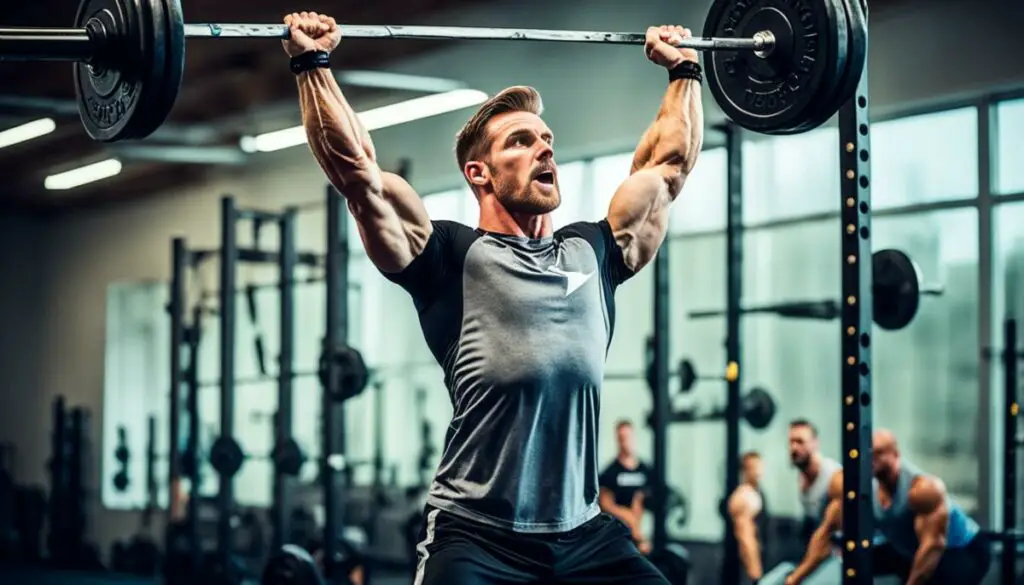
The hang high pull is an effective exercise that offers numerous benefits for athletes and fitness enthusiasts. Whether you’re looking to gain muscle mass or improve your strength training routine, incorporating the hang high pull into your workouts can significantly enhance your overall fitness level.
1. Muscle Development:
The hang high pull targets several muscle groups, making it a great exercise for building muscle mass. This exercise primarily works the posterior chain, including the lower back, hamstrings, and glutes. By engaging these muscles, the hang high pull contributes to improved overall strength and power.
2. Athletic Performance:
In addition to muscle development, the hang high pull is also beneficial for enhancing athletic performance. This exercise specifically targets the neck and traps, which play a crucial role in reducing the risk of concussions. By strengthening these areas, athletes can better protect themselves during high-impact sports and activities.
3. Wrist-Friendly Option:
The hang high pull provides minimal stress on the wrists, making it an ideal exercise for those who may have concerns about wrist injuries. Unlike other pulling exercises that may place strain on the wrists, the hang high pull allows for a more comfortable and safer grip, enabling individuals to focus on maximizing their workout without worrying about potential wrist discomfort.
Incorporating the hang high pull into your fitness routine can help you achieve your goals of building muscle mass, improving strength, and enhancing athletic performance.
<!–
| Benefits | Description |
|---|---|
| Muscle Development | The hang high pull targets the posterior chain, including the lower back, hamstrings, and glutes, promoting muscle growth and strength. |
| Athletic Performance | By strengthening the neck and traps, the hang high pull reduces the risk of concussions and enhances overall athletic performance. |
| Wrist-Friendly Option | The hang high pull provides minimal stress on the wrists, making it a suitable exercise for individuals concerned about wrist injuries. |
–><!–
“The hang high pull is a versatile exercise that offers a range of benefits, from muscle development to enhancing athletic performance. By incorporating this exercise into your training routine, you can take your fitness journey to new heights.”
–><!–
Things to Keep in Mind:
- Proper form is crucial when performing the hang high pull. Ensure you maintain a slight bend in your knees and engage your core for stability.
- Start with lighter weights and gradually increase the load as you become more comfortable and proficient with the exercise.
- Always prioritize safety during your workouts. If you have any concerns or questions about incorporating the hang high pull into your routine, consult with a qualified fitness professional.
–>
How to Perform the Hang High Pull
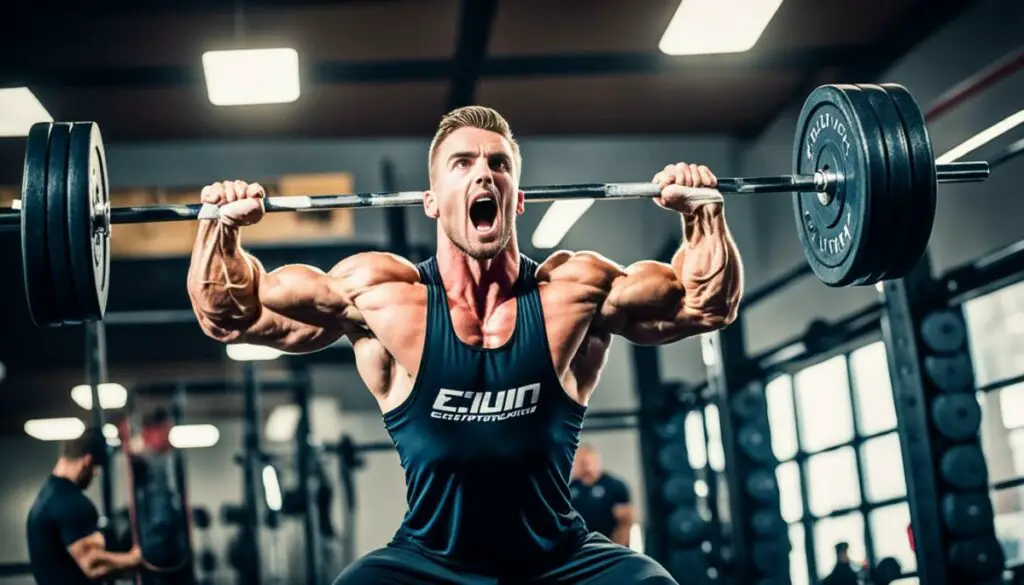
To properly execute the hang high pull, follow these step-by-step instructions:
- Start with the barbell at thigh height, gripped with both hands using an overhand grip.
- Position your feet shoulder-width apart with your knees slightly bent, maintaining a stable base.
- From the hanging position, initiate the movement by extending your legs explosively, rising onto the balls of your feet.
- Simultaneously, initiate a powerful shrug with your shoulders to generate momentum.
- As the barbell rises, pull it as high as possible without turning your wrists or catching the weight.
- Once the barbell reaches its highest point, let it drop back down under control.
- Return to the starting position and repeat the movement for the desired number of repetitions.
When performing the hang high pull, it’s important to maintain proper form and technique. Here are some tips to ensure you get the most out of this exercise:
- Engage your core throughout the movement to maintain stability and control.
- Keep your back straight and avoid rounding your shoulders to prevent injury.
- Remember to breathe properly, exhaling as you generate power during the pull.
- Focus on explosive, controlled movements to maximize power production.
- Practice with a lighter weight or dowel rod to perfect your form before adding more weight.
Hang High Pull Variations
While the traditional hang high pull is highly effective on its own, incorporating variations into your training routine can provide additional benefits and prevent plateaus. Here are a few hang high pull variations to consider:
- Snatch Grip High Pull: Perform the hang high pull using a snatch grip, which widens your hand placement and targets different muscle groups.
- Clean Grip High Pull: Use a clean grip, placing your hands closer together, to emphasize the muscles used in the clean movement.
- Kettlebell High Pull: Swap the barbell for a kettlebell to add a different challenge and increase grip strength.
- Band-Resisted High Pull: Attach a resistance band to the barbell or kettlebell to increase resistance throughout the movement.
By incorporating these variations, you can keep your workouts fresh, target different muscle groups, and continue progressing towards your fitness goals.
Now that you know how to perform the hang high pull and have learned some variations, you can confidently include this exercise in your training routine. Remember to prioritize safety, maintain proper form, and progressively increase the weight as you become more comfortable and proficient with the movement.
Muscles Worked in the Hang High Pull
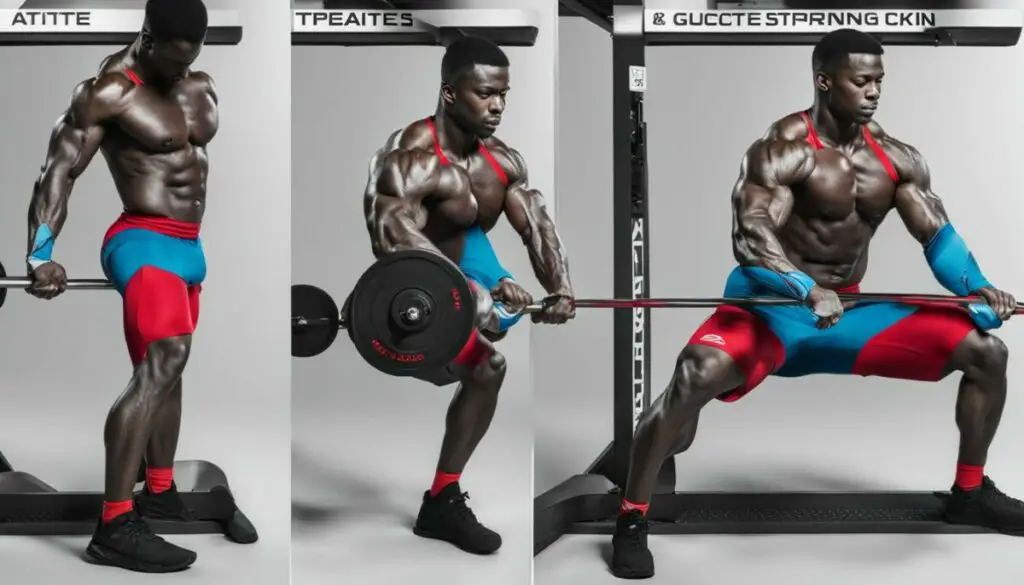
The hang high pull is a compound exercise that targets multiple muscle groups, making it an effective full-body movement for developing strength and power. The primary muscles worked during the hang high pull include:
- Posterior Chain: The hang high pull heavily engages the muscles of the posterior chain, which include the lower back, hamstrings, and glutes. These muscles play a crucial role in generating power and explosiveness during movements.
- Neck and Traps: As you perform the hang high pull, the muscles in your neck and traps are also activated. These muscles help stabilize and support the upper body throughout the exercise.
- Shoulders: The shoulder muscles, including the deltoids and rotator cuff muscles, are involved in controlling the movement of the barbell during the hang high pull.
- Biceps: Your biceps are also recruited to a certain extent during the pulling phase of the hang high pull, assisting in the movement of the barbell.
By targeting these muscle groups, the hang high pull helps improve overall strength, power, and muscular coordination necessary for explosive movements and athletic performance.
| Muscle Group | Primary Muscles |
|---|---|
| Posterior Chain | Lower back, hamstrings, glutes |
| Neck and Traps | Trapezius, neck muscles |
| Shoulders | Deltoids, rotator cuff muscles |
| Biceps | Biceps brachii |
Engaging these muscle groups through the hang high pull can contribute to improved athletic performance, functional strength, and overall muscle development.
The Hang High Pull vs. Other Pulling Exercises
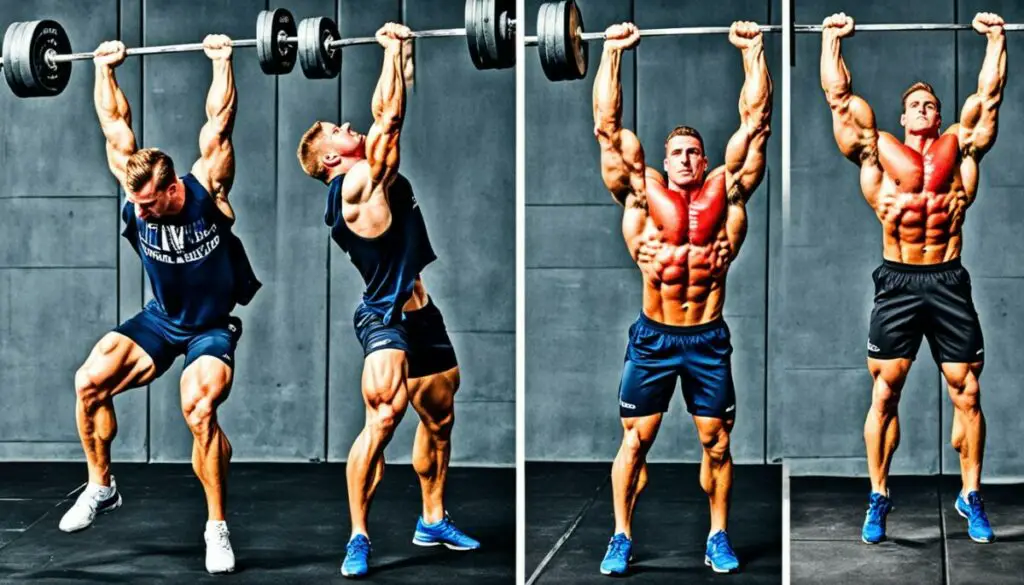
The hang high pull is often compared to other pulling exercises, such as the power clean and clean pull. While these exercises have similar movements, they have some key differences.
“The hang high pull is a fantastic exercise for developing explosive power and strength. It targets the posterior chain and helps improve technique for Olympic lifts like the clean and snatch.”
Let’s take a closer look at how the hang high pull compares to these other pulling exercises:
The Hang High Pull vs. Power Clean
The power clean is a popular exercise in weightlifting and strength training. It involves pulling the barbell from the floor to the shoulders in one fluid motion. While the hang high pull and power clean both target the posterior chain and require explosive power, there are some distinct differences:
- The hang high pull starts from a hang position, while the power clean starts from the floor.
- In the hang high pull, the focus is on the explosive extension of the legs and shrugging of the shoulders, without catching the weight. In the power clean, the goal is to catch the weight in a front rack position after the pull.
- The power clean requires more technique and coordination to perform correctly, as it involves the transition from the pull to the catch phase.
Both exercises can be beneficial for developing power and improving overall athletic performance. However, the hang high pull may be a better choice for those who want to focus on explosive power without the complexity of catching the weight in the front rack position.
The Hang High Pull vs. Clean Pull
The clean pull is another exercise commonly used in weightlifting and strength training. It involves pulling the barbell from the floor to the hips, mimicking the first part of the power clean without the catch phase. Here’s how the clean pull differs from the hang high pull:
- The hang high pull starts from a hang position, while the clean pull starts from the floor.
- Both exercises emphasize the explosive extension of the legs and shrugging of the shoulders, but the hang high pull focuses on pulling the bar as high as possible without catching the weight, while the clean pull stops at the hips.
- The clean pull allows lifters to handle heavier loads compared to the hang high pull, as it eliminates the need for the catch phase and requires less overall technique.
Both the hang high pull and clean pull have their benefits and can be incorporated into a well-rounded training program. The hang high pull is great for developing explosive power and technique, while the clean pull is effective for building strength and reinforcing proper pulling mechanics.
By understanding the differences between these exercises, you can choose the one that best suits your training goals and preferences.
Tips for a Powerful Finish in the Hang High Pull
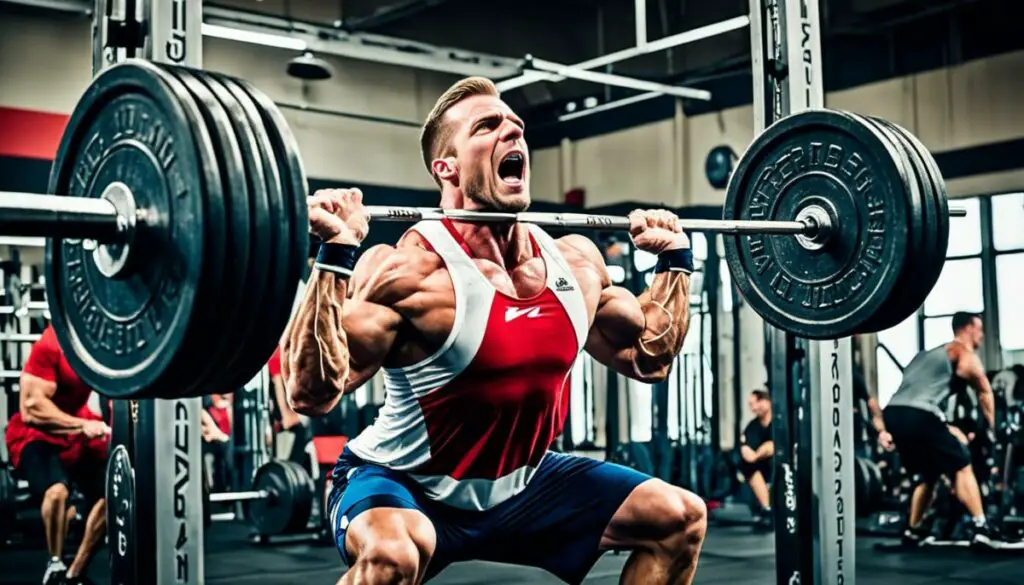
A powerful finish is crucial in the hang high pull to maximize the benefits of the exercise. To achieve a strong finish, focus on maintaining proper body positioning and mechanics throughout the movement. Ensure that you fully extend your legs and shrug your shoulders explosively at the end of the pull. This will generate momentum and allow the barbell to reach its highest point.
By fully extending your legs, you engage the powerful muscles of your lower body, transferring energy from the ground up. This explosive extension helps propel the barbell upwards and adds momentum to the lift.
Additionally, shrugging your shoulders explosively at the top of the movement further activates the muscles of your upper body, specifically targeting the traps and upper back. This enhances the overall power and effectiveness of the hang high pull.
Remember to maintain a strong grip on the barbell throughout the exercise, as this will ensure proper control and stability as you perform the movement.
Practicing proper technique and focusing on a powerful finish in the hang high pull will help you optimize muscle engagement, build strength, and improve your overall performance.
Tips for a Powerful Finish:
- Maintain proper body positioning and mechanics.
- Fully extend your legs to generate momentum.
- Explosively shrug your shoulders at the top of the movement.
- Keep a strong grip on the barbell.
Observations for Improving the Hang High Pull
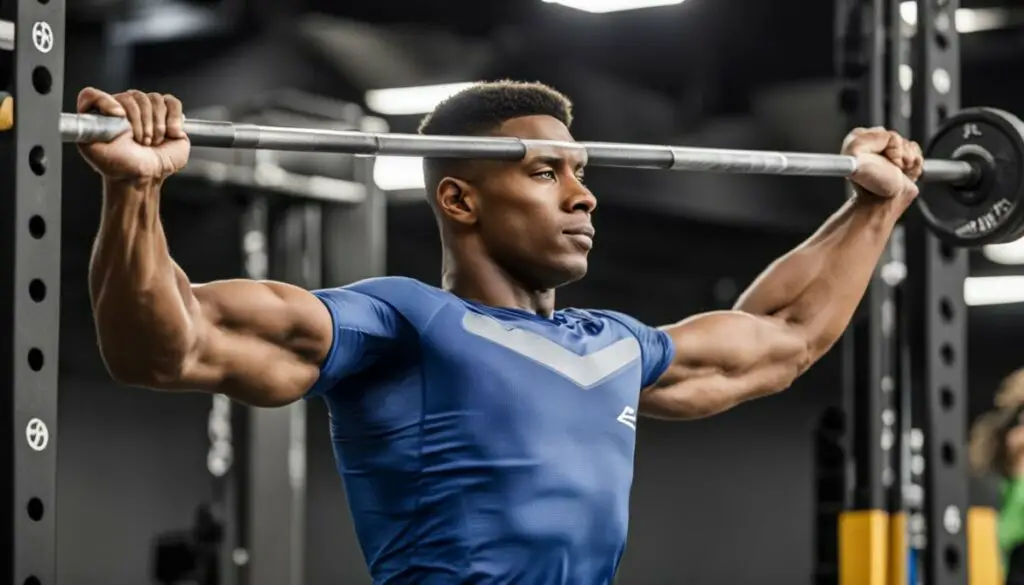
Improving the hang high pull requires consistent practice and attention to detail. To enhance your performance and maximize the benefits of this exercise, it’s important to focus on the transition between the deadlift part and the shrug part of the movement. By ensuring a smooth and fluid motion during this transition, you can effectively engage the necessary muscle groups and generate power at the finish.
“The key to improving the hang high pull lies in the seamless flow between the deadlift and the shrug. This allows for a powerful transfer of energy and recruits the targeted muscles efficiently.”
When executing the hang high pull, pay close attention to the timing and coordination of your movements. As you initiate the pull, think about extending your hips and knees explosively, using the power generated from the lower body to drive the barbell upwards. Simultaneously, focus on shrugging your shoulders to raise the bar even higher. This seamless integration of the deadlift and the shrug will enhance the effectiveness of the exercise and help you achieve optimal results.
Remember to maintain proper form throughout the entire movement. Keep your core engaged, chest up, and shoulder blades retracted. This will ensure that you are maximizing the engagement of the targeted muscles and minimizing the risk of injury.
Expert Tip:
To further improve your hang high pull, consider incorporating variations into your training routine. Some popular variations include:
- Hang high pull with dumbbells
- Hang high pull from different starting positions (mid-thigh, below the knee)
- Hang high pull with resistance bands
- Hang high pull into a clean or snatch
These variations can add challenge and variety to your workouts, helping you progress and overcome plateaus in strength and power development.
| Observation | Recommendation |
|---|---|
| The transition between the deadlift and shrug should be smooth and fluid | Practice the movement with lighter weights to focus on the coordination and timing |
| Ensure proper form throughout the exercise | Engage your core, maintain a neutral spine, and retract your shoulder blades |
| Consider incorporating variations of the hang high pull into your training | Try different starting positions, use different equipment, and integrate the exercise into compound movements like the clean or snatch |
Importance of Height and Velocity in the Hang High Pull
The hang high pull is a dynamic exercise that requires a careful balance of height and velocity. The barbell must be pulled to a certain height to ensure proper positioning and catching of the weight, especially in Olympic lifts like the snatch and clean.
To execute the hang high pull effectively, it’s crucial to understand the significance of height. The height achieved during the pull determines the amount of force generated and the degree of activation in the targeted muscle groups.
When performing the hang high pull, strive to pull the barbell as high as possible without compromising form. The optimal height will vary depending on factors such as individual strength, flexibility, and training goals. However, a general guideline is to aim for a height that allows you to comfortably transition into the catch position for Olympic lifts.
Velocity – Unleashing Power in the Hang High Pull
In addition to height, velocity plays a vital role in the hang high pull. The speed at which you execute the pull significantly impacts the power output and overall effectiveness of the exercise.
By prioritizing explosive velocity in the upward phase of the movement, you can maximize muscle recruitment and force production. This explosive power not only enhances performance in the hang high pull but also carries over to other athletic movements that require speed and power, such as sprinting and jumping.
Keep in mind that velocity should not compromise technique or control. Focus on maintaining proper form throughout the entire range of motion, emphasizing a quick and forceful extension of the legs and a powerful shrug of the shoulders.
Achieving Optimal Height and Velocity: Key Considerations
To optimize height and velocity in the hang high pull, consider the following factors:
- Strength and Technique: Developing adequate strength and mastering proper technique are fundamental prerequisites for maximizing height and velocity. Regular strength training, flexibility work, and technical drills specific to the hang high pull can help you progress in these areas.
- Progressive Overload: Gradually increasing the load used in the hang high pull over time can help build strength and explosiveness, ultimately contributing to improved height and velocity.
- Focused Training: Dedicate specific training sessions to honing height and velocity in the hang high pull. Incorporate variations and drills that target these aspects to reinforce the desired movement patterns.
Remember, mastering the hang high pull is a continuous process that requires dedication and consistent practice. By prioritizing optimal height and velocity, you can unlock your full potential and reap the benefits of this dynamic exercise.
Exercises to Improve the Hang High Pull
To enhance your performance in the hang high pull, it’s important to incorporate a variety of exercises into your training routine. By including these exercises, you can target different muscle groups and develop the explosive power necessary for a strong finish in the hang high pull.
1. High Pulls with a Snatch Grip
A variation of the hang high pull, high pulls with a snatch grip can help improve your technique and strengthen the muscles involved in the movement. To perform this exercise, assume the hang position with a wider grip on the barbell, similar to the snatch grip. From there, execute a powerful pull using the same mechanics as the hang high pull. This variation places additional emphasis on the shoulders, upper back, and traps.
2. High Pulls with a Conventional Clean Grip
Another effective variation is high pulls with a conventional clean grip. This exercise mimics the grip used in the clean, allowing you to focus on developing the pulling strength and explosiveness required for that movement. Begin in the hang position, gripping the barbell with a clean grip (hands slightly wider than shoulder-width apart). Initiate the pull by extending your legs, shrugging your shoulders, and pulling the barbell as high as possible without catching the weight. The conventional clean grip high pull targets the posterior chain, upper back, and biceps.
By incorporating these exercises into your training routine, you can enhance your hang high pull technique, strengthen key muscle groups, and improve your overall explosive power. Remember to start with lighter weights and gradually increase the load as you become more comfortable and proficient in the movements.
Conclusion
The hang high pull is a highly effective exercise for athletes and fitness enthusiasts seeking to enhance their strength, power, and explosiveness. By incorporating this exercise into your training routine, you can enjoy numerous benefits, including improved technique for Olympic lifts, strengthened posterior chain muscles, and reduced stress on the wrists.
The hang high pull is particularly valuable for athletes aiming to refine their form in movements like the clean. It allows for explosive power generation and teaches the proper mechanics necessary for successful execution of Olympic lifts. Additionally, it targets key muscle groups in the posterior chain, including the lower back, hamstrings, and glutes, enabling significant gains in overall strength and muscle mass.
One of the standout advantages of the hang high pull is its low impact on the wrists. This makes it an ideal exercise for individuals with wrist concerns or those who have experienced previous wrist injuries. By engaging in hang high pulls, you can minimize wrist strain while still maximizing the benefits of a challenging and effective workout.
FAQ
What muscles does the hang high pull work?
The hang high pull primarily works the posterior chain, including the lower back, hamstrings, and glutes. It also engages the neck, traps, shoulders, and biceps.
How does the hang high pull compare to other pulling exercises?
While the hang high pull has similar movements to exercises like the power clean and clean pull, it has some key differences in terms of technique and muscle engagement.
How do I perform the hang high pull?
To perform the hang high pull, start with the barbell at thigh height, hold it with an overhand grip and feet shoulder-width apart. From the hanging position, extend your legs, rise on the balls of your feet, and shrug your shoulders to pull the barbell as high as possible without catching the weight.
What are the benefits of doing the hang high pull?
The hang high pull offers several benefits including strengthening the posterior chain, reducing the risk of concussions, and providing minimal stress on the wrists.
How can I improve my hang high pull finish?
To achieve a strong finish in the hang high pull, focus on maintaining proper body positioning and mechanics throughout the movement. Fully extend your legs and shrug your shoulders explosively at the end of the pull to generate momentum and reach the barbell’s highest point.
What are some tips for improving the hang high pull?
To improve the hang high pull, practice the transition between the deadlift and shrug parts of the movement, ensuring a smooth and fluid motion. This will help engage the necessary muscle groups and generate power at the finish.
Why is height and velocity important in the hang high pull?
Height and velocity are important considerations in the hang high pull as the barbell must be pulled to a certain height to allow for proper positioning and catching the weight in Olympic lifts like the snatch and clean.
What exercises can I do to improve my hang high pull?
In addition to the hang high pull itself, exercises like high pulls with a snatch grip and a conventional clean grip can be helpful. These exercises target different muscle groups and help develop explosive power for a strong finish in the hang high pull.









